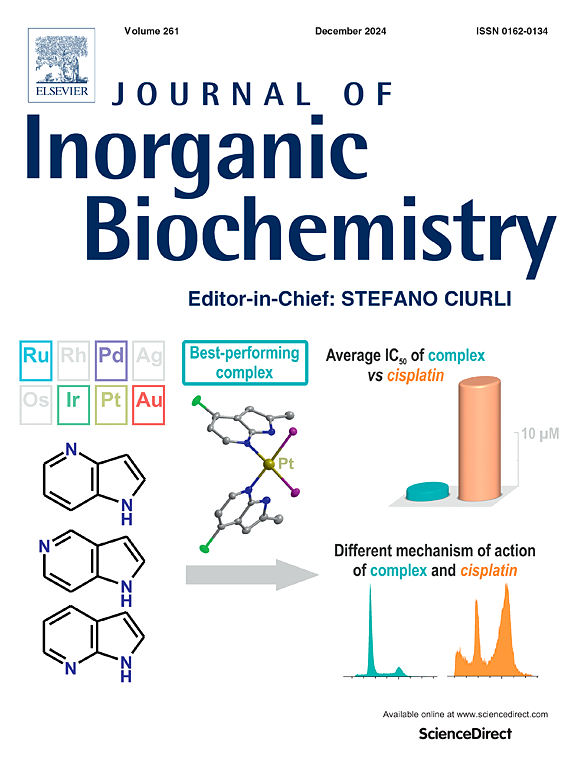银(I),锌(II)和镓(III)噻吩-2-羧酸盐:合成,溶液和固态表征和生物评价
IF 3.8
2区 化学
Q2 BIOCHEMISTRY & MOLECULAR BIOLOGY
引用次数: 0
摘要
合成了三种不同中心原子为Ag(I)、Zn(II)和Ga(III)、[Ag(Tio2c)]2 (AgTio2c)、{[Zn2(Tio2c)4]2}n (ZnTio2c)和[Ga(Tio2c)3]·H2O (GaTio2c)的2-噻吩羧酸盐(Tio2c)配合物,并用元素、光谱和热分析对其进行了表征。AgTio2c和ZnTio2c单晶结构证实了最常见的双齿桥接配位模式,在AgTio2c配合物中具有典型的强亲银相互作用。配合物在生物试验原液中的稳定性通过1H NMR谱证实。用BSTAC程序对四种低丰度络合物[Zn(Tio2c)]+ (log β110 = 2.06±0.04)、[Zn(Tio2c)(OH)] (log β11-1 =−5.0±0.1)、[Zn(Tio2c)(OH)2]−(log β11-2 =−12.9±0.4)和[Zn(Tio2c)2(OH)2]2−(log β12-2 =−8.54±0.04)在水溶液中的稳定常数进行了电位分析。理论分析表明,水溶液中[Zn(Tio2c)]+络合物具有较强的单齿Tio2c配位模式,而羟基络合物更倾向于羧酸盐的双齿O,O ' -键。抗菌和抗癌生物试验清楚地证实了AgTio2c复合物的最高生物活性(毒性)。与GaTio2c相比,ZnTio2c的活性略高(或相同)。利用荧光光谱研究了AgTio2c、ZnTio2c和GaTio2c配合物与HSA(人血清白蛋白)的结合行为,结果表明,计算得到的Kb值约为104 M−1。本文章由计算机程序翻译,如有差异,请以英文原文为准。

Silver(I), Zinc(II) and Gallium(III) thiophene-2-carboxylates: Synthesis, solution and solid state characterization and bioevaluation
Three 2-thiophenecarboxylate (Tio2c) complexes with different central atoms Ag(I), Zn(II) and Ga(III), [Ag(Tio2c)]2 (AgTio2c), {[Zn2(Tio2c)4]2}n (ZnTio2c) and [Ga(Tio2c)3]·H2O (GaTio2c), were synthesized and elemental, spectral and thermal analyses were used for their characterization. The AgTio2c and ZnTio2c single crystal structures confirmed the most common bidentate bridging coordination mode with typical strong argentophilic interactions in the case of AgTio2c complex. Complexes' stability in biological test stock solution were confirmed by 1H NMR spectroscopy. Potentiometric data analysis by BSTAC program resulted in the determination of the stability constants of four complex species, [Zn(Tio2c)]+ (log β110 = 2.06 ± 0.04), [Zn(Tio2c)(OH)] (log β11–1 = −5.0 ± 0.1), [Zn(Tio2c)(OH)2]− (log β11–2 = −12.9 ± 0.4) and [Zn(Tio2c)2(OH)2]2− (log β12–2 = −8.54 ± 0.04) with low abundance in aqueous solution. Theoretical estimation of the complex species in aqueous solution indicates a rather monodentate Tio2c coordination mode in the [Zn(Tio2c)]+ species, while the hydroxido complex species prefer a rather bidentate O,Oʼ-bond of the carboxylate. Antimicrobial and anticancer bioassays clearly confirmed the highest biological activity (toxicity) of the AgTio2c complex. The activity of ZnTio2c was slightly higher (or the same) compared to GaTio2c. The HSA (human serum albumin) binding behaviour of the AgTio2c, ZnTio2c and GaTio2c complexes was investigated using fluorescence spectroscopy and results revealed that the calculated Kb values were in the order of 104 M−1.
求助全文
通过发布文献求助,成功后即可免费获取论文全文。
去求助
来源期刊

Journal of Inorganic Biochemistry
生物-生化与分子生物学
CiteScore
7.00
自引率
10.30%
发文量
336
审稿时长
41 days
期刊介绍:
The Journal of Inorganic Biochemistry is an established international forum for research in all aspects of Biological Inorganic Chemistry. Original papers of a high scientific level are published in the form of Articles (full length papers), Short Communications, Focused Reviews and Bioinorganic Methods. Topics include: the chemistry, structure and function of metalloenzymes; the interaction of inorganic ions and molecules with proteins and nucleic acids; the synthesis and properties of coordination complexes of biological interest including both structural and functional model systems; the function of metal- containing systems in the regulation of gene expression; the role of metals in medicine; the application of spectroscopic methods to determine the structure of metallobiomolecules; the preparation and characterization of metal-based biomaterials; and related systems. The emphasis of the Journal is on the structure and mechanism of action of metallobiomolecules.
 求助内容:
求助内容: 应助结果提醒方式:
应助结果提醒方式:


